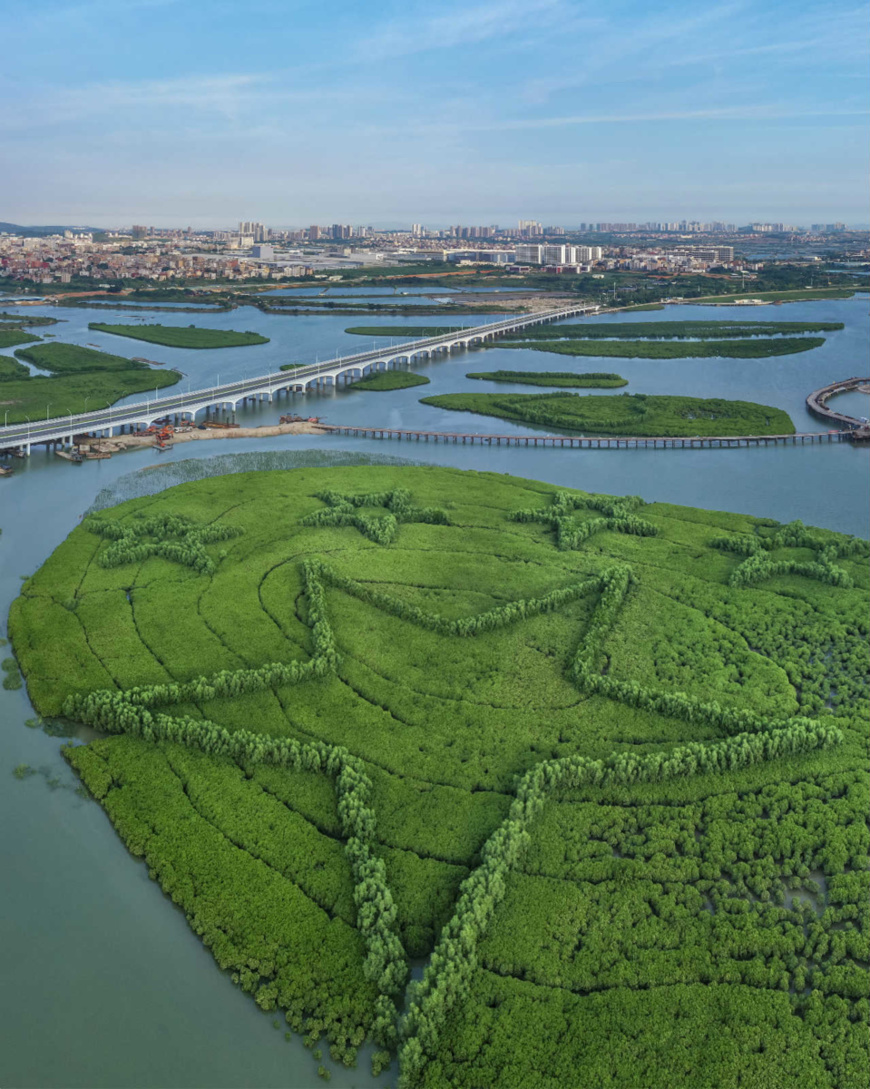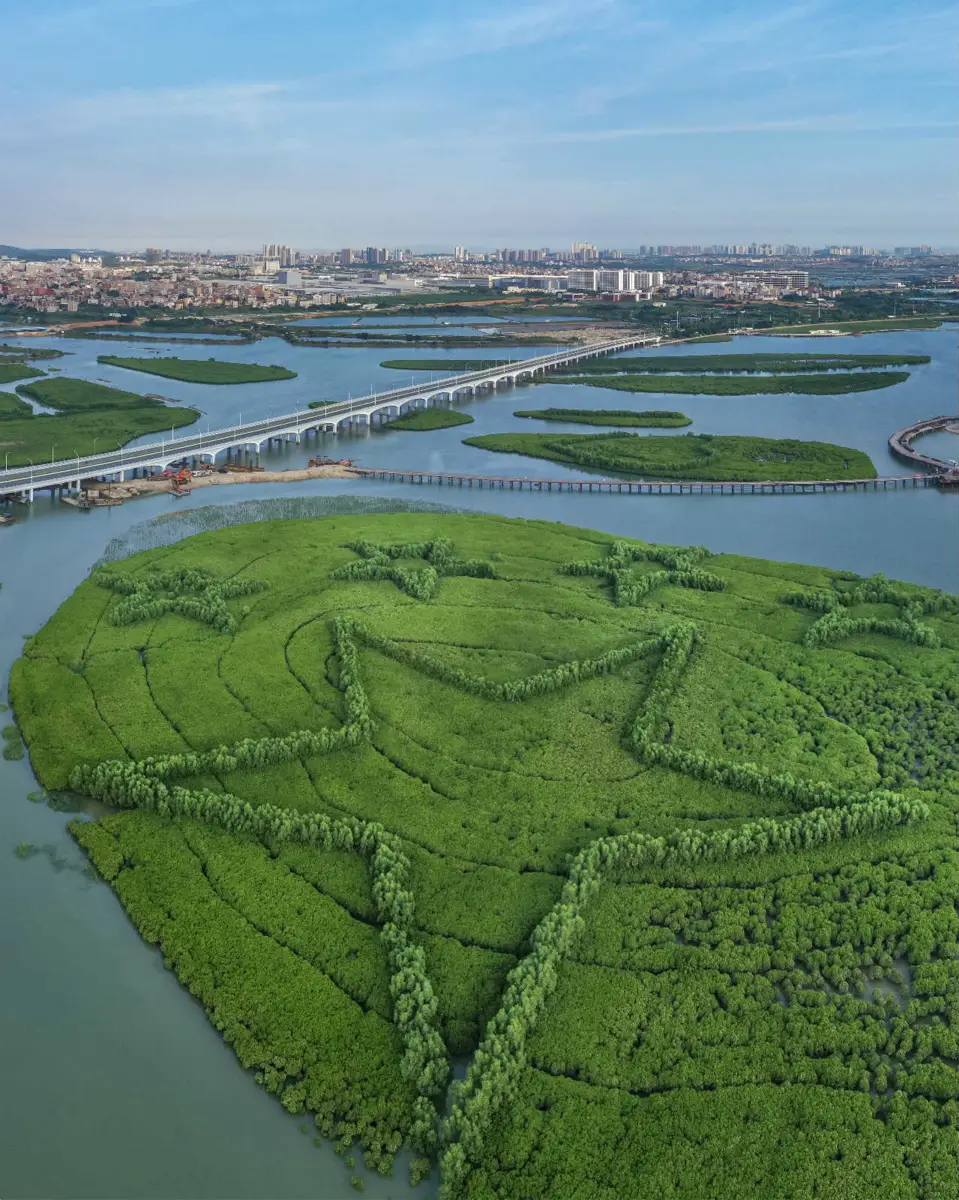By Chang Qin, People’s Daily

Photo taken on July 25, 2019 shows a wetland park in Xiamen, East China’s Fujian Province. The wetland park is the largest-ever artificial mangrove project in Xiamen. Photo by Su Huaqi/People’s Daily Online
China will have created and restored 18,800 hectares of mangrove forests by 2025, said an action plan recently issued by China’s Ministry of Natural Resources and National Forestry and Grassland Administration (NFGA).
Of the total, 9,050 hectares of mangrove forests will be built over the next five years, and 9,750 hectares will be rehabilitated.
The action plan, aiming at the protection and restoration of mangrove forests during the 2020-2025 period, will ensure strict protection for existing mangrove forests and scientific measures for mangrove ecological restoration, so as to expand the coverage of mangrove forests, increase biodiversity, and comprehensively improve the ecological system of mangrove forests.
Mangrove forests mostly grow on tropical and subtropical intertidal zones and are regarded as a typical part of the marine ecosystem as important as coral reefs, salt marshes, and seagrass beds.
Because of their important roles in various aspects of marine ecosystem conservation, such as seawater purification, prevention and dissipation of winds and waves, carbon sequestration and storage, as well as biodiversity maintenance, mangrove forests are praised as “coast guards” and a “green lung of the ocean”.
When mangrove forests are inundated by seawater at high tides, they become a shelter for fish, shrimp, crab, and shellfish to inhabit in and reproduce. After the tide falls, they would become a “heaven” for birds.
China has 37 kinds of mangrove plants which are mainly distributed in coastal provinces and autonomous regions such as Guangdong, Guangxi, Hainan, Fujian and Zhejiang.
With the joint efforts of governments at all levels and relevant departments of the country, China has maintained a stable growth in the coverage of mangrove forests in the recent two decades, said Wu Zhimin, director of the wetland management department of the NFGA.
Last year, the coverage of mangrove forests in China reached around 29,000 hectares, and the country’s ecological situation of mangrove forests was also improved, according to Wu.
“It should also be seen that China’s mangrove ecosystem is still facing problems and quite a lot of threats,” Wu said, adding that these problems and threats have all been listed as key issues in the action plan, and that the country will take concrete measures to address them step by step.
Establishing conservation areas is an important approach to protect mangrove forests. At present, 52 nature reserves in the Chinese mainland have mangrove forests that cover 15,944 hectares, more than 55 percent of the country’s total mangrove forests coverage.
China’s protected mangrove forests areas are mainly located in the coastal areas and island in the southeast, according to Yuan Jiming, deputy director of the protected natural areas management department of the NFGA, explaining that the regions where mangrove forests are distributed are densely populated and enjoy rapid economic development.
“Certain protected areas are still troubled by the insufficiency of management organizations, lax supervision, and invasion of alien species,” Yuan said.
The action plan proposed to include all the mangrove forests in China in the country’s ecological protection zoning map, and specified relevant regulatory requirements.
China’s natural resources supervision and examination authorities and relevant departments are also expected to intensify efforts to keep the area, functions and nature of the country’s mangrove forests.
As the coverage of mangrove forests is declining around the world, East China’s Zhejiang Province, the northern boundary of the country’s mangrove forests, has increased the mangrove forest coverage in its territory with each passing year.
Thanks to its efforts to protect coastal wetlands and rehabilitate the ecological environment of coastlines, Zhejiang is now home to 1,333.33 hectares of mangrove forests.
The survival rate and preserving rate of mangrove plants are key to the restoration of mangrove forests.
In the past, because of the lack of science-based approaches, some regions in the country failed to create forests though they kept planting trees every year. Regarding this, the action plan has set specific goals in creating and restoring mangrove forests, so reasonable and rational plans of afforestation must be ensured.
Relevant techniques, specifications and standards must be established, and follow-up management for the mangrove forests must be ensured after they are created, said Zhou Yuanbo, an official with the Ministry of Natural Resources.
Natural restoration and moderate human efforts should be combined to ensure comprehensive protection and systematic restoration of mangrove forests, Zhou noted.
The Ministry of Natural Resources will provide financial support for local efforts to create and restore mangrove forests based on the central government funding for marine ecological protection and restoration endeavors.
The Ministry of Natural Resources and Ministry of Finance have invested 600 million yuan ($87.72 million) in this year’s Blue Bay Initiative to support relevant provincial-level regions in the country in their efforts to push forward mangrove forests protection and restoration projects.
Of the total, 9,050 hectares of mangrove forests will be built over the next five years, and 9,750 hectares will be rehabilitated.
The action plan, aiming at the protection and restoration of mangrove forests during the 2020-2025 period, will ensure strict protection for existing mangrove forests and scientific measures for mangrove ecological restoration, so as to expand the coverage of mangrove forests, increase biodiversity, and comprehensively improve the ecological system of mangrove forests.
Mangrove forests mostly grow on tropical and subtropical intertidal zones and are regarded as a typical part of the marine ecosystem as important as coral reefs, salt marshes, and seagrass beds.
Because of their important roles in various aspects of marine ecosystem conservation, such as seawater purification, prevention and dissipation of winds and waves, carbon sequestration and storage, as well as biodiversity maintenance, mangrove forests are praised as “coast guards” and a “green lung of the ocean”.
When mangrove forests are inundated by seawater at high tides, they become a shelter for fish, shrimp, crab, and shellfish to inhabit in and reproduce. After the tide falls, they would become a “heaven” for birds.
China has 37 kinds of mangrove plants which are mainly distributed in coastal provinces and autonomous regions such as Guangdong, Guangxi, Hainan, Fujian and Zhejiang.
With the joint efforts of governments at all levels and relevant departments of the country, China has maintained a stable growth in the coverage of mangrove forests in the recent two decades, said Wu Zhimin, director of the wetland management department of the NFGA.
Last year, the coverage of mangrove forests in China reached around 29,000 hectares, and the country’s ecological situation of mangrove forests was also improved, according to Wu.
“It should also be seen that China’s mangrove ecosystem is still facing problems and quite a lot of threats,” Wu said, adding that these problems and threats have all been listed as key issues in the action plan, and that the country will take concrete measures to address them step by step.
Establishing conservation areas is an important approach to protect mangrove forests. At present, 52 nature reserves in the Chinese mainland have mangrove forests that cover 15,944 hectares, more than 55 percent of the country’s total mangrove forests coverage.
China’s protected mangrove forests areas are mainly located in the coastal areas and island in the southeast, according to Yuan Jiming, deputy director of the protected natural areas management department of the NFGA, explaining that the regions where mangrove forests are distributed are densely populated and enjoy rapid economic development.
“Certain protected areas are still troubled by the insufficiency of management organizations, lax supervision, and invasion of alien species,” Yuan said.
The action plan proposed to include all the mangrove forests in China in the country’s ecological protection zoning map, and specified relevant regulatory requirements.
China’s natural resources supervision and examination authorities and relevant departments are also expected to intensify efforts to keep the area, functions and nature of the country’s mangrove forests.
As the coverage of mangrove forests is declining around the world, East China’s Zhejiang Province, the northern boundary of the country’s mangrove forests, has increased the mangrove forest coverage in its territory with each passing year.
Thanks to its efforts to protect coastal wetlands and rehabilitate the ecological environment of coastlines, Zhejiang is now home to 1,333.33 hectares of mangrove forests.
The survival rate and preserving rate of mangrove plants are key to the restoration of mangrove forests.
In the past, because of the lack of science-based approaches, some regions in the country failed to create forests though they kept planting trees every year. Regarding this, the action plan has set specific goals in creating and restoring mangrove forests, so reasonable and rational plans of afforestation must be ensured.
Relevant techniques, specifications and standards must be established, and follow-up management for the mangrove forests must be ensured after they are created, said Zhou Yuanbo, an official with the Ministry of Natural Resources.
Natural restoration and moderate human efforts should be combined to ensure comprehensive protection and systematic restoration of mangrove forests, Zhou noted.
The Ministry of Natural Resources will provide financial support for local efforts to create and restore mangrove forests based on the central government funding for marine ecological protection and restoration endeavors.
The Ministry of Natural Resources and Ministry of Finance have invested 600 million yuan ($87.72 million) in this year’s Blue Bay Initiative to support relevant provincial-level regions in the country in their efforts to push forward mangrove forests protection and restoration projects.
 Menu
Menu
 China to have 18,800 hectares of mangrove forests by 2025: action plan
China to have 18,800 hectares of mangrove forests by 2025: action plan
















